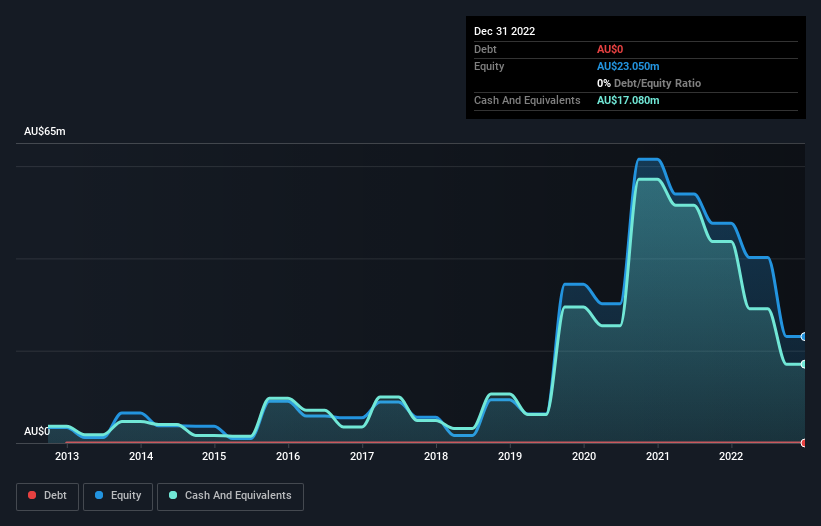We Think PYC Therapeutics (ASX:PYC) Needs To Drive Business Growth Carefully
Even when a business is losing money, it's possible for shareholders to make money if they buy a good business at the right price. For example, although software-as-a-service business Salesforce.com lost money for years while it grew recurring revenue, if you held shares since 2005, you'd have done very well indeed. But the harsh reality is that very many loss making companies burn through all their cash and go bankrupt.
So, the natural question for PYC Therapeutics (ASX:PYC) shareholders is whether they should be concerned by its rate of cash burn. For the purpose of this article, we'll define cash burn as the amount of cash the company is spending each year to fund its growth (also called its negative free cash flow). The first step is to compare its cash burn with its cash reserves, to give us its 'cash runway'.
See our latest analysis for PYC Therapeutics
SWOT Analysis for PYC Therapeutics
- Currently debt free.
- Expensive based on P/S ratio compared to estimated Fair P/S ratio.
- Shareholders have been diluted in the past year.
- PYC's financial characteristics indicate limited near-term opportunities for shareholders.
- Has less than 3 years of cash runway based on current free cash flow.
How Long Is PYC Therapeutics' Cash Runway?
A company's cash runway is the amount of time it would take to burn through its cash reserves at its current cash burn rate. In December 2022, PYC Therapeutics had AU$17m in cash, and was debt-free. Importantly, its cash burn was AU$26m over the trailing twelve months. Therefore, from December 2022 it had roughly 8 months of cash runway. To be frank, this kind of short runway puts us on edge, as it indicates the company must reduce its cash burn significantly, or else raise cash imminently. Depicted below, you can see how its cash holdings have changed over time.

How Is PYC Therapeutics' Cash Burn Changing Over Time?
Although PYC Therapeutics reported revenue of AU$14m last year, it didn't actually have any revenue from operations. That means we consider it a pre-revenue business, and we will focus our growth analysis on cash burn, for now. During the last twelve months, its cash burn actually ramped up 95%. Oftentimes, increased cash burn simply means a company is accelerating its business development, but one should always be mindful that this causes the cash runway to shrink. Clearly, however, the crucial factor is whether the company will grow its business going forward. For that reason, it makes a lot of sense to take a look at our analyst forecasts for the company.
How Easily Can PYC Therapeutics Raise Cash?
Since its cash burn is moving in the wrong direction, PYC Therapeutics shareholders may wish to think ahead to when the company may need to raise more cash. Companies can raise capital through either debt or equity. Many companies end up issuing new shares to fund future growth. We can compare a company's cash burn to its market capitalisation to get a sense for how many new shares a company would have to issue to fund one year's operations.
Since it has a market capitalisation of AU$212m, PYC Therapeutics' AU$26m in cash burn equates to about 12% of its market value. As a result, we'd venture that the company could raise more cash for growth without much trouble, albeit at the cost of some dilution.
How Risky Is PYC Therapeutics' Cash Burn Situation?
Even though its increasing cash burn makes us a little nervous, we are compelled to mention that we thought PYC Therapeutics' cash burn relative to its market cap was relatively promising. Looking at the factors mentioned in this short report, we do think that its cash burn is a bit risky, and it does make us slightly nervous about the stock. Taking a deeper dive, we've spotted 4 warning signs for PYC Therapeutics you should be aware of, and 1 of them is a bit unpleasant.
If you would prefer to check out another company with better fundamentals, then do not miss this free list of interesting companies, that have HIGH return on equity and low debt or this list of stocks which are all forecast to grow.
New: Manage All Your Stock Portfolios in One Place
We've created the ultimate portfolio companion for stock investors, and it's free.
• Connect an unlimited number of Portfolios and see your total in one currency
• Be alerted to new Warning Signs or Risks via email or mobile
• Track the Fair Value of your stocks
Have feedback on this article? Concerned about the content? Get in touch with us directly. Alternatively, email editorial-team (at) simplywallst.com.
This article by Simply Wall St is general in nature. We provide commentary based on historical data and analyst forecasts only using an unbiased methodology and our articles are not intended to be financial advice. It does not constitute a recommendation to buy or sell any stock, and does not take account of your objectives, or your financial situation. We aim to bring you long-term focused analysis driven by fundamental data. Note that our analysis may not factor in the latest price-sensitive company announcements or qualitative material. Simply Wall St has no position in any stocks mentioned.
About ASX:PYC
PYC Therapeutics
A drug-development company, engages in the discovery and development of novel RNA therapeutics for the treatment of genetic diseases in Australia.
Flawless balance sheet with high growth potential.
Similar Companies
Market Insights
Community Narratives



